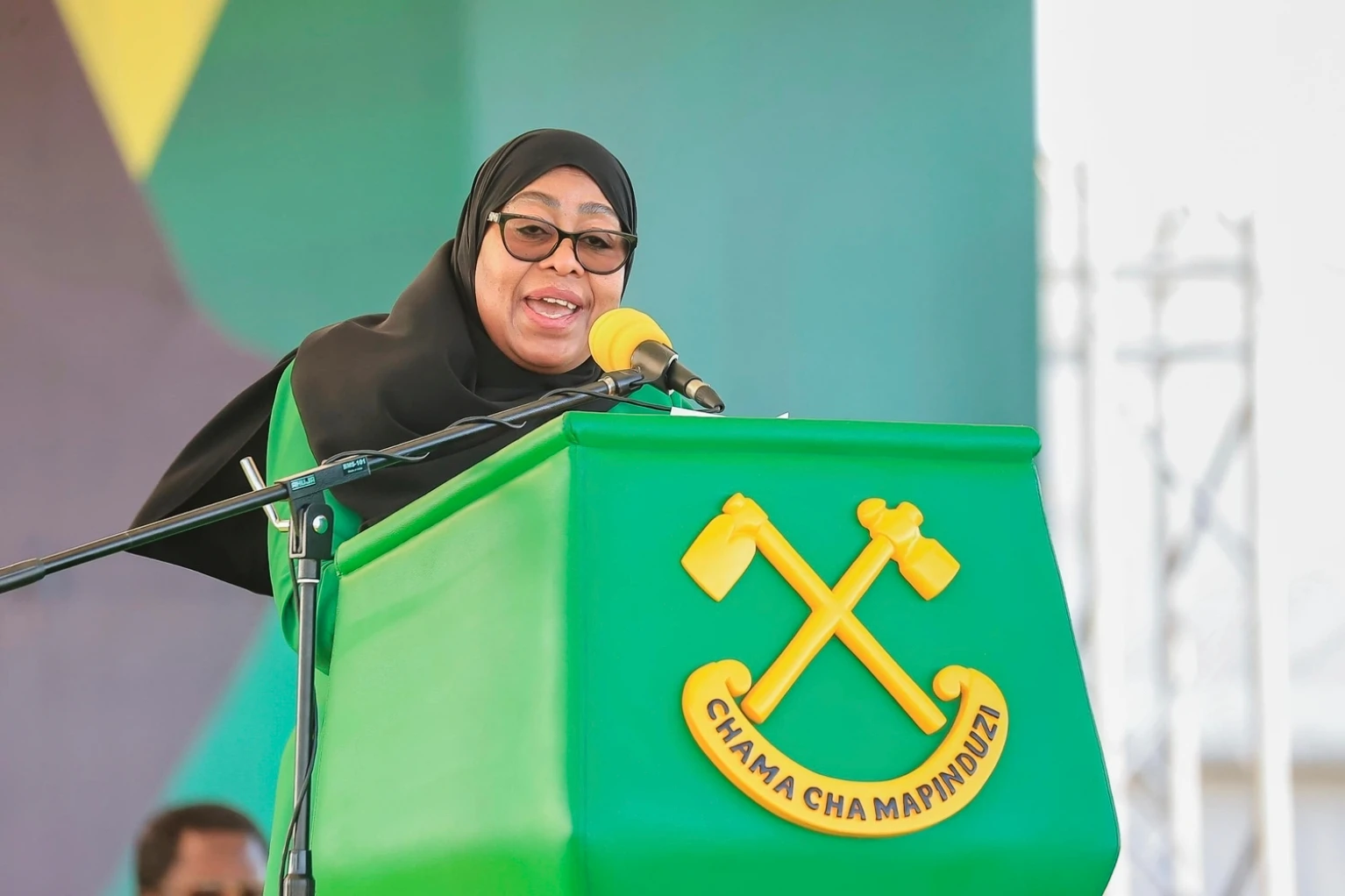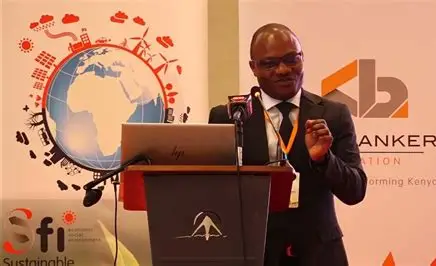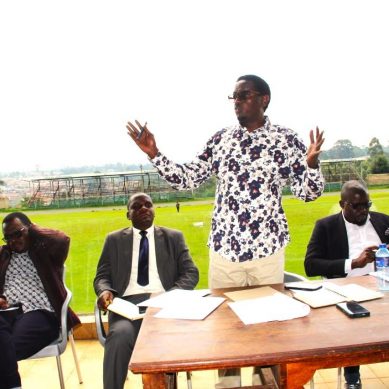
One school of thought states that the Wanga Kingdom of the Luhya of Kenya was founded in the 16th century by Nabongo Wanga, a descendant of the rulers of the Buganda Kingdom. The Nabongo Wanga initially settled in the defunct Nyanza Province of Kenya before moving the capital to Mumias, of the defunct Western Province of Kenya.
The kingdom covered the west from Jinja in Uganda to Naivasha in the central in Kenya. Some historians posit that the kingdom’s boundaries stretched to Lake Magadi along the Indian Ocean coast.
It was led by a king who bore the title Nabongo (king) and was the most organised political institution in pre-colonial Kenya.
It is interesting that the name Nabongo is prevalent in Buganda and Busoga as well as western Kenya. According to Juma Kwayera (pers. Comm.), it may be that the envoys from the Luhya to Busoga and Buganda had that name. Or else some Luhyia could have migrated to Busoga and Buganda since the kingdoms were friendly and had diplomatic relations, and decided and were allowed to stay by the powers that be in Busoga and Buganda.
In fact, in Busoga, there is a place called Buluya and the name Kaluya is common in Kigulu county of present day Iganga District. This could partly explain the settlement of the people of the Nabongo of the Wanga Kingdom or the Luhyia. However, Juma Kwayera (pers. comm.) narrates that there was a king of the Wanga Kingdom..
The Wanga King (Mwami of Omwami) was called the Nabongo the same way the King of Busoga was called Isebantu and the King of Buganda was called Kabaka. The Nabongo presided over the entire Luhyialand. However, the kingdom was recognised by the name of his small indigenous group, the Wanga. The other small indigenous groups had vassal kings that were all under the Nabongo. The vassal kings enjoyed regal authority as delegated by the central authority at Eshihembekho (Kraal). Historically, there was a king of Kitara who was called Nyabongo. So, the name Nabongo could have Busoganised from Bunyoro-Kitara or imported from Luhyialand.
Juma Kwayera (pers.comm.) explains that the Luhyia Kingdom, generally known as Wanga Kingdom, bordered Busoga of long ago, in the west and extended all the way up to Lake Naivasha to the East. Some historians write that the Kingdom extended up to Lake Magadi. This could explain why Uganda’s President Idi Amin claimed a huge slice of western Kenya to have been unfairly transferred to Kenya by the British colonialists. However, Amin himself later said he had no intention of taking an inch of the neighbour’s land, adding “All I was doing was to remind Ugandans of their past history and geography”. In fact, he directed all Ugandans to buy the paper The Voice of Uganda of February 16, 1976, in which he detailed the former boundaries of the country. He said “Uganda’s borders were beyond Juba and Torit in the Sudan and all areas of western Kenya up to 30 kilometres west of Nairobi”. He later stressed his views of Uganda’s borders in his book titled “The Shaping of Modern Uganda and Administrative Divisions” published in 1976. He denied planning war to claim the lost lands. Whatever the case, the Basoga and the Luhyia were interacting a lot before the colonialists arrived and started to pursue their interests.
It is interesting, according to Juma Kwayera (pers. comm.) that some names such as Iganga, Mayuge, Bukooli, et. cetera, are names also found in western Kenya. Besides, in Kakamega, there is a group of people called Basogo or Basoga. Their name means “skilled swimmers” or “skilled tree climbers”.
This is interesting. In Luuka district of Busoga, Uganda, in an area called Nankongolo, there were skilled tree climbers. These exploited the fact that the Basoga of those days would keep their harvests in the branches of trees, away from the ground where there were pathogens (bacteria and fungi that could make their food rot. and from thieves that could steal the food. Those skilled tree climbers would swiftly go up the trees like monkeys or baboons and come down with the heavy food and then run off at terrific speed with the loads on their backs.
Besides, members of my own clan, the Mulawa clan called Balawa, whose origin was the Busoga part of Buvuma Island in Lake Victoria, before the arrival of the colonialists, were very skilled fishermen and boat-makers. They would fish like the bird called Kingfisher, which dives into the water to catch fish. The boat, which took the first colonialists to Entebbe, the seat of colonial power, was made by the Balawa, who also steered it to Entebbe and back to Butamba in Buvuma.
Apparently while I lived in Kenya from 1980 to 1991, I could hear on radio drumming and singing similar to Basoga drumming and singing. Even whenever I went to Malawi, I could get the same impression. According to Juma Kwayera (pers. comm.), the Isukuti song and dance in Kakamega, Kenya, are like that of the Basoga of Uganda. It has been so for centuries.
The Basoga, Baganda and Luhya did not only harmoniously interact. They also intermarried. Besides, if there were Chwezi in Luhyialand, Busoga and Buganda. Juma Kwayera (pers.com) says that there is a clan among the Kabras – a subtribe – called Bachezi or Bachetsi. It is believed they have power of control over lightning and can tickle it to laugh like a human being. Since Bachwezi were or are associated with witchcraft and divine powers as we shall see later in this treatise, it is possible the Bachezi or Bachetsi are a remnant group of the Chwezi. After all, the Chwezi dynasty or Kitara Kingdom included Western Kenya.
There is no evidence to suggest that Bachezi or Bachetsi ruled in Luhyialand. However, the presence of Nyabongo in the Chwezi-established Kitara Kingdom as a name of one of the rulers and a Nabongo in Luhyialand could suggest a connection between the Nabongo of Luhyialand and the Chwezi kings of Kitara. After all Kitara included Western Kenya. Therefore, the Bachezi or Bachetsi of Luhyialand, in Western Kenya, must have belonged to the gene pool of the Chwezi who established the Chwezi Dynasty and/or Kitara kingdom/empire.
Chwezi cult of the Igaga clan in Busoga
Today the Chwezi are represented in Busoga by the Igaga clan, which as I will show later in this treatise, established a vestige of the Chwezi dynasty at Nnenda Hill in Busambira, Kigulu County and ruled Busoga for centuries from around 1233 long before the collapse of the Kitara Empire in the 16th century and the arrival of the British colonialists in the 19th Century who went on to erase the Chwezi dynasty at Nnenda Hill. And established their own hegemony over Busoga. Cohen (1968, 2009) wrote about the Chwezi cult in Busambira, Kigulu, Busoga.
There is no evidence to suggest that the Chwezi directly ruled in Buganda. It was the Luo Babiito that ruled in Buganda Kingdom. But some names of the Kitara kings are known in Buganda although in modified form.
The similarities between the Luhyia and Basoga may suggest that there existed a powerful and extensive nation in this part of the Lake Victoria basin that Arabs and white colonialists interfered with, thereby interrupting its political, social and economic transformation and progress, despite the fact that it was part of the Kitara Empire (Kwayera, pers. comm) of the Chwezi. As I will show elsewhere in this treatise, the area was very rich in minerals – both gold and rare earth minerals. In fact, Buganda sub-imperialism benefitted a lot from this wealth.
Busoga: The cosmopolitan country
Busoga is a truly cosmopolitan area composed of people, constituents or elements from all or many parts of East Africa. While there must have been original people in the area, which came to be known as Busoga, the present-day Basoga came from two directions at different times. Those living in the south, it is said, came from the Masaba region (Mt Elgon), moved westwards and settled in different places of current Busoga. Those in the North came from Bunyoro according to the oral tradition (Oral tradition – story of Omukama and his sons). Cohen (2009) reviewed several different efforts to comprehend and represent the evolving contacts between Bantu-speakers in the Busoga area and, in particular, Luo-speaking immigrants.
Over the long run, many groups associated with Luo immigration took over Bantu speech while gaining dominant statuses and positions within the largely Bantu-speaking communities in the area. Some of the important population flows in Busoga appear to have developed out of reactions to elaborated forms of domination building over a number of years, rather than as instant expressions of boundary and cultural formation by the participants in the experience (Cohen, 2009). Concurrently, traditions, culture and spirituality of the Basoga underwent many changes to reflect the happenings of the time.
The most popular music and dance of the Basoga are called Tamenhaibuga (Isabirye, 2012). Bigwala, gourd trumpet music and dance, performed during royal celebrations such as coronations and funerals and, in recent decades, on social occasions, is also popular (Isabirye, 2012). I suspect that these could reflect the influence of the Chwezi on Basoga culture.
Busoga: The traditional nation or country
A nation has been described as a large body of people united by common descent, history, culture or language, inhabiting a particular country or territory. Busoga may be referred to as a traditional nation or country. When we talk about traditional ‘country’ we mean something beyond the dictionary definition of the word. We might mean homeland or indigenous people’s or clan area and we might mean more than just a place on the map.
The word traditional means following or conforming to tradition: adhering to past practices or established conventions. Traditional morality. Traditional values/beliefs. Employing traditional methods of cooking. Despite President Tibuhaburwa Yoweri Museveni trying hard to tear up and bantustanise Busoga over a period of 38 years using the colonial tool of divide and rule, the Basoga still value their traditions. The Basoga have a rich cultural past that is ingrained in their customs and practices. In fact, Busoga must be viewed as a traditional Bantu group and cultural institution as recognised by the Uganda Constitution of 1995. The Basoga have long endured unfair ridicule and baseless comparisons to the Baganda, stemming from the misconception that they merely mimic the latter.
Historical inferiority complex of the Basoga vis-a-vis Baganda
It is important to note that the supposed superiority complex of Buganda is not as pronounced as it is often portrayed and similarly, the perceived inferiority of Busoga is unfounded. It is just that Buganda has consistently held a strategic position that has bestowed upon it certain advantages, elevating it above other ethnic groups, hence the notion of Buganda ku ntikko” (Buganda above the rest, Basajjabaka, 2023).
It should be noted that the colonialists regarded Basoga as another group on the other side of the Nile that was not significantly different from the Baganda on the other side of the Nile.
Early colonial writers thought that what they wrote about Baganda applied to Basoga. This explains why there was a paucity of literature on Busoga and Basoga by the time the British granted independence to the Commonwealth Realm of Uganda on October 9, 1962, subsequently being renamed Uganda on the first anniversary of Independence on October 9, 1963.
Geology of Busoga and western Kenya and latent culture of minerals
The culture of minerals is integral to the sterile culture of money. Prospecting for minerals has always been an aspect of the pursuit of riches, usually by power, but also by unscrupulous people, but at the expense of the people who belong to the areas containing the minerals. Usually, the people who belong to the mineral rich are either impoverished further or left to wallow in poverty as their minerals are carried away. They are often told the minerals belong to the nations of which they were made to be part of by the colonialists and that they are for the benefit of all. However, historically the people who are the real owners of the minerals have lost out. In Busoga the people have been told by none other than President Tibuhaburwa Museveni that they should leave the issue of minerals to government and concentrate on producing food for those active in the mining industry.
Geologically, Busoga in Uganda and Kakamega in Kenya have the same mineral-rich rock formation. extends into the Democratic Republic of Congo (DRC). Juma Kwayera (pers. comm.) believes it is not coincidental that people in these parts of the world are choreographed via scatter and rule to be subservient to power or political wielders of power.
Busoga at the moment is suffering the military occupation of Lake Victoria and the traditional fishermen can no longer easily access fish. Besides, Busoga is the richest in gold reserves and reserves of rare earth minerals in Uganda, but the modern occupiers of the region have strategised to exclude them from the benefits of mineral wealth both beneath Lake Victoria and on the mainland.
Meanwhile the minerals are being clandestinely exploited by Chinese, Indians and people connected to power or the military for selfish ends.
The Kenyan part of the Lake Victoria Basin has minerals that include Kisii soapstone, phosphate, sulphur, wollastonite and nephelinite, manganese, tin, kaolin, clay, fluorspar, iron ore, graphite and diatomaceous soil. A range of minerals – cassiterite, coltan, wolfram and colombo tantalum – and other valuable materials such as sand, gravel and stones are extracted in various parts of the Lake Victoria Basin in Rwanda.
Busoga does not only have the largest freshwater lake in the world – Lake Victoria – but also has Lake Kyoga. Lake Victoria is not only rich in fish but also in rare minerals in its basement rocks. Mainland Busoga is one continuous mine of numerous minerals, including Cerium, Dysprosiumerbium, Europium, Gadolinium, Holmium and Lanthanum, essential for the manufacture of medical equipment, smart phones, laptops and electric car batteries, among others. Platinum is found in the basement rocks of Lake Victoria. Kaliro district, according to mining cadastre, has cobalt, copper, Nikel and platinum group metals. Kamuli has graphite. Iganga district has gold and nickel whereas Mayuge has gold and iron ore. Namayingo has gold, copper, zinc and other precious metals. Bugiri has platinum group metals, which include platinum, palladium, rhodium, ruthenium as well as gold, potash and other base metals. Luuka District has platinum group of metals (PGM). The Busoga region also has industrial minerals such as clay, sand and coltan.
For some of the minerals such as gold, Busoga is said to be next to only China in the whole world. For example, Busoga’s gold is worth $12 trillion – nearly equivalent to the economy of the United States. There is already a gold refinery in Uganda since 2014 called African Gold Refinery (AGR) and owned by a Belgian known as Alain Goetz and operating in Central Entebbe. Although many thought it is gold stolen from eastern Democratic Republic of Congo that was being refined in Uganda, one school of thought believes a lot of the gold is gold stolen from Busoga and Karamoja.
AGR was inaugurated in 2021 by President Tibuhaburwa Museveni who hailed it as “the first high-capacity gold refinery in Africa south of the Sahara. By February 23, 2017, AGR was processing 250Kg of gold per week, worth $204 million (193 million euros) in 2016. Gold was Uganda’s second leading export after coffee.
However, AGR produced far less than the amount of gold that left the country. As Wandera, cited by Monitor (2017) said, “Poor monitoring of the gold mining sector makes it nearly impossible to know how much gold left the country, especially because so much of the gold is smuggled. We now know Busoga has the biggest gold reserves in the Great Lakes Region but it is being clandestinely mined and the rest of the smuggled gold comes from South Sudan and the DRC.
Busoga may be rich in minerals but it has yet to benefit even in the minutest way. The leaders of Busoga are silent as if they have not heard that the region is one huge mine of a diversity of minerals. They have joined the singing of the song of poverty in Busoga instead of organising politically to demand that the region benefits from its enormous mineral wealth and use the benefit to power the people out of poverty. Instead, they see growing of sugar cane for Asian exploiters as the way out of poverty.
- A Tell report / By Oweyegha-Afunaduula / Environmental Historian and Conservationist Centre for Critical Thinking and Alternative Analysis (CCTAA), Seeta, Mukono, Uganda.
About the Centre for Critical Thinking and Alternative Analysis (CCTAA)
The CCTAA was innovated by Hyuha Mukwanason, Oweyegha-Afunaduula and Mahir Balunywa in 2019 to the rising decline in the capacity of graduates in Uganda and beyond to engage in critical thinking and reason coherently besides excellence in academics and academic production. The three scholars were convinced that after academic achievement the world outside the ivory tower needed graduates that can think critically and reason coherently towards making society and the environment better for human gratification. They reasoned between themselves and reached the conclusion that disciplinary education did not only narrow the thinking and reasoning of those exposed to it but restricted the opportunity to excel in critical thinking and reasoning, which are the ultimate aim of education. They were dismayed by the truism that the products of disciplinary education find it difficult to tick outside the boundaries of their disciplines; that when they provide solutions to problems that do not recognise the artificial boundaries between knowledges, their solutions become the new problems. They decided that the answer was a new and different medium of learning and innovating, which they characterised as “The Centre for Critical Thinking and Alternative Analysis” (CCTAA). They saw their innovation as a new opportunity to demystify disciplinary education and open up academia and society to new, interlinked knowledge and solutions to complex or wicked problems that disciplinary education cannot solve. To this end, the CCTAA promotes linking of knowledge through the knowledge production systems of Interdisciplinarity, Crossdisciplinarity, Transdisciplinarity and Extradisciplinarity (or non-disciplinarity), which allow for multistakeholder team knowledge production instead of individualised knowledge production, which glorifies individual knowledge production, achievement and glorification.
The issue of alternative analysis towards deconstruction and reconstruction of knowledge is taken seriously at the CCTAA. Most recorded knowledge needs deconstruction and reconstruction within the context of new and different knowledge production systems listed here in. Therefore, instead of disciplinary academics, scholars or professionals, we can begin to produce new ones. We can, for example have professors of interdisciplinarity, crossdisciplinarity, transdisciplinarity and extradisciplinarity or non-disciplinarity. Besides, academics, scholars and/or professionals, civil servants, researchers, etc can choose to reorient themselves via the CCTAA and become enhanced learners via the new and different knowledge systems.
It is attitudinal change to thinking, reasoning and practice in knowledge production and use towards solving simple and complex problems! We are all learning beings, and by virtue of the construction of our brains we are supposed to continuously learn and to be good at thinking correctly and reasoning effectively. As learners who can engage in critical thinking and alternative analysis, we become more open to change and alternatives to development, transformation and progress of society, embrace change, imagine possibilities, learn through the activity of experience, and rejuvenate ourselves and ourselves continuously. The CCTAA is committed to enabling this to happen. It does not abhor resistance but creates opportunities for meaningful resistance that opens opportunities for all.








